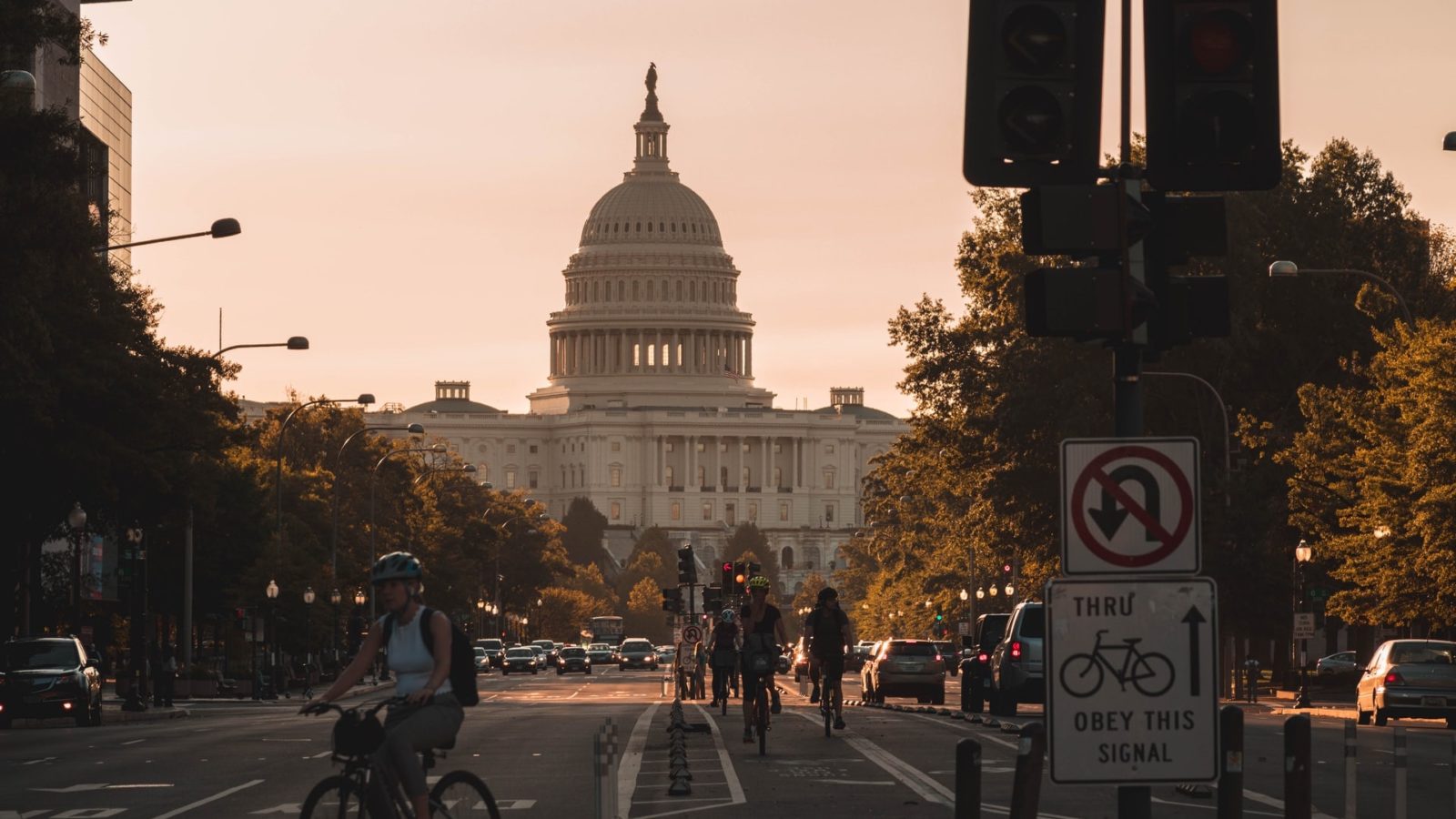This Sunday, the Senate passed the Inflation Reduction Act of 2022 through the budget reconciliation process. The bill contains many provisions originally included in President Biden’s Build Back Better legislation, including almost $370 billion for climate investments.
Overall, the bill has been lauded by climate groups, but it does contain some concessions to the fossil fuel industry to secure Senator Manchin’s support. Additionally, Senator Schumer made a promise for future legislation that will speed the permitting process for energy infrastructure projects, including natural gas pipelines.
Still, the climate benefits from the Inflation Reduction Act appear to heavily outweigh the concessions needed to bring Senator Manchin to the table. According to modeling from Energy Innovation, for every ton of greenhouse gasses generated from the Inflation Reduction Act’s oil and gas provisions, 24 tons are avoided by the bill’s other provisions. The modeling also found that the Inflation Reduction Act can help the U.S. reduce emissions to 40 percent below 2005 levels by 2030, getting the country closer to Biden’s target of 50 percent and to the U.S. commitments of the Paris Agreement.
The Inflation Reduction Act is expected to be passed in the House and signed into law by the president. While the bill is the most significant piece of federal legislation on climate, it has major tools to help states continue to take action. Let’s take a look at what climate provisions are in the Inflation Reduction Act, and what its passing means for states.
How the Inflation Reduction Act Affects States
The Inflation Reduction Act includes billions of dollars for states, municipalities, and Tribal governments to implement plans and programs to address climate change. Here are some of the main opportunities.
Green Bank Funding
The Inflation Reduction Act sets aside $27 billion for the Greenhouse Gas Reduction Fund, creating the country’s first national green bank. The money from this new program can then be used to help fund state and local green banks. A green bank is a public, quasi-public, or nonprofit financial institution that utilizes public funds to attract private investment in clean energy projects. Whereas the primary goal of a regular bank is profit, green banks exist first and foremost to promote investments in projects that reduce greenhouse gas emissions.
Technological advancements will be key to reducing emissions at the rate necessary to meet our climate goals, but sometimes it’s hard for projects to get off the ground. Some emerging technologies may not have fully developed markets, which can make lenders wary to invest, fearing they may not see a return on their investment. While this makes economic sense for investors, it means that new clean energy projects can fail to secure the capital needed to get started through traditional sources.
Green banks help address this issue by using public funds up-front to encourage additional private investment down the road. There are many different techniques green banks have to do this, including providing financial security to a hesitant lender or aggregating many small projects into one, more diversified investment. It’s important to note that while green banks can be highly effective in financing clean energy projects, they are still a bank and expect their investments to be paid back.
Green banks can provide communities historically underinvested in with financing options for clean energy projects, make projects more affordable , create markets and new job opportunities in environmental justice and low-to-moderate income communities. In fact, $8 billion of the total investments in the Greenhouse Gas Reduction Fund must go towards financial and technical assistance for low-income and disadvantaged communities.
The $27 billion from the IRA’s Greenhouse Gas Reduction Fund can be used to help states start new green banks. Usually green banks require an initial investment of public dollars to get started and then through investments are able to leverage additional private money to replace the public funding. Some states and cities in the U.S. already have green banks, but many more can benefit from them. Existing green banks in the U.S. have leveraged about $3 of private money for every $1 of public money spent, but some experts estimate that a federal green bank could be even more effective.
Community Development Programs
The Inflation Reduction Act contains $3 billion for the Neighborhood Access and Equity Grants Program and lists state and local governments as entities eligible for the funding. The money from this program can be used by states and cities to improve disadvantaged communities with infrastructure improvement projects.
The Inflation Reduction Act’s text lists that communities eligible for funding must be:
- Economically disadvantaged;
- Entered into community benefits agreement with representatives of the community;
- Have an anti-displacement policy, community land trust, or community advisory board; or
- Demonstrated plan for employing local residents by the proposed project
The text of the legislation describes exactly what the grant money can be used for, with all projects resulting in benefits for residents of the grantee’s community. For example, grant money can be used on projects that improve walkability, safety, and transportation access like Syracuse’s plan to replace an elevated highway with ground-level streets and surrounding neighborhood development projects. Such a project would begin to rectify the discriminatory nature of the 1950’s infrastructure and use federal dollars to benefit the whole community.
Pollution Reduction
The Inflation Reduction Act amends a section of the Clean Air Act, the 1970 law that governs the ability of the Environmental Protection Agency (EPA) to protect the country’s air quality. Specifically, it adds language to the Clean Air Act for Climate Pollution Reduction Grants, which sets aside two separate pots of money: planning grants and implementation grants.
First, the legislation provides $250 million for states to develop plans to reduce greenhouse gas emissions. The EPA must make this planning grant available to at least one eligible entity in every state. Entities include state governments, air pollution control agencies, municipalities, or Tribal governments. Then, the EPA will have a total of $5.75 billion to competitively award grants to any eligible entities to implement their plans to reduce climate pollution.
Climate plans are an important policy to help states meet their climate targets. Plans can be proposed by state executive offices, but the most effective ones have legislative origins and are written with input from climate advisory bodies. To secure funding from the Climate Pollution Reduction Grants, plans need to include programs, policies, measures, and projects that will reduce greenhouse gas pollution, how much will be reduced, and how it will be measured.
Fossil Fuel Royalty Rates
The federal government charges fossil fuel companies a royalty fee to drill on public lands, but the current rate hasn’t been updated in a century. The IRA proposes an increase in that rate from 12.5 percent to at least 16.6 percent of the value of fossil fuels extracted. The higher rate would bring the cost of drilling on federal land closer to what it costs on state land, where rates range from 16.6 percent to 25 percent.
While a higher royalty rate doesn’t actually prevent drilling for fossil fuels, it would make it more expensive which can make renewable alternatives more competitive. It’s also significant that the bill would codify a higher royalty rate into law, strengthening an order that the Biden administration gave this spring to raise the rate when they began to resume oil and gas leasing on federal lands.
A higher federal royalty rate on oil and gas extraction helps state governments, because they receive half of the revenue from leases that are within their borders. States use this revenue to fund infrastructure projects, education, and public health, and a higher federal rate means more money to spend. Since the current rate is lower than what experts say that it should be, states have been missing out on funding while companies were still drilling. Accountable.US, a nonprofit watchdog, found that in 2019, Western states missed out on $1.58 billion had the royalty rate been 20 percent instead of 12.5 percent.
This provision in the Inflation Reduction Act really only helps states in the immediate future, as it does little to actually stop oil and gas drilling, especially while demand for domestic fuels remains high. It may raise state revenues in the short term, but with the increasing need to transition from fossil fuels to renewable energy, eventually the funding will decrease.
Home Electrification Rebates
The commercial and residential building sector contributed to 13 percent of U.S. greenhouse gas emissions in 2020, with a large portion coming from non-electrified homes. The Inflation Reduction Act provides billions of dollars to help states and Tribal governments give rebates to homeowners for electrification and energy efficiency improvements.
The bill sets aside $4.3 billion for states to develop and implement Home Owner Managing Energy Savings (HOMES) rebate programs. HOMES programs provide rebates to homeowners for whole-house energy savings retrofits. The amount of the rebate is based on the demonstrated energy savings in the home, with higher savings earning higher rebates. The HOMES program also extends rebates to multifamily buildings like apartments and affordable housing.
There is additional funding for states and Tribal governments to give rebates to homeowners for specific electrification projects. Entities eligible for these rebates must be either low- or moderate-income households, an owner of a mostly low- or moderate-income apartment building, or another entity representing low- or moderate-income-households. Qualified projects include heat pumps, insulation, air sealing, electric wiring, and upgrades to circuit breakers. The bill lists different amounts for each project with a maximum rebate of $14,000 per eligible entity.
What Else is in the Inflation Reduction Act?
The world is currently feeling sticker shock from inflationary prices, including from gasoline and other fossil fuels. Some have used this situation to call for increasing the global supply of fossil fuels, but this would only provide short term economic relief, when in reality transitioning to renewable energy will provide greater long-term stability in energy prices.
More than anything, the Inflation Reduction Act contains tax incentives, in the form of credits and deductions, that are designed to increase demand for renewable energy and investments in clean infrastructure. Additionally, there are other funding mechanisms and programs for agencies to support low-carbon projects in all major economic sectors. Here is a non-exhaustive summary of the categories in the bill.
Clean Energy and Grid Modernization
- Renewable Energy Production Tax Credit – This is a per kilowatt-hour federal tax credit for electricity generated by renewable resources. The current production tax credit was in place for any projects constructed before January 2022. The Inflation Reduction Act would extend this credit for projects for another ten years.
- Investment Tax Credit – This incentive allows taxpayers to deduct a percentage of qualifying investments from their annual taxes. The current investment tax credit is commonly used for solar investments, but the Inflation Reduction Act would extend it to encompass other investments including: manufacturing for electric vehicles (EVs), wind turbines, and solar panels, energy storage, some biogas, and microgrid controllers.
- Low-Income Solar and Wind Investment Tax Credit – The Inflation Reduction Act would increase the incentive for investments in wind and solar built in or connected to low-income communities.
- Other Tax Credits – There are additional tax credits for carbon capture projects, nuclear energy production, and technology-neutral net-zero generators or storage facilities.
Transportation
- Tax Credits for Electric Vehicles – The Inflation Reduction Act extends the tax credits for the purchase of new and used electric vehicles. New EVs qualify for $7,500 in credits with income levels capped at $150,000 for individuals or $300,000 for a household. Used EVs qualify for $4,000 with income capped at $75,000 for individuals or $150,000 for households. The Inflation Reduction Act also eliminates the cap that disqualifies manufacturers that have sold more than 200,000 vehicles, which would re-include Tesla and General Motors in the program. The bill also attempts to ramp up domestic manufacturing by requiring that final assembly of qualifying EVs must take place in America. Though this excludes some foreign manufacturers, the Department of Energy released a list of vehicles that are currently eligible, subject to updates.
- Creates or extends tax credits for EV charging/alternative fuel properties, biodiesel and alternative fuels, and sustainable aviation fuel.
- Provides funding for:
- U.S. Postal Service EV fleet and charging infrastructure ($3.045 billion)
- Zero-emission equipment and technology at ports ($3 billion)
- Clean heavy-duty vehicles like buses and garbage trucks ($1 billion)
Buildings and Energy Efficiency
- Tax Credits:
- Residential Energy Efficiency – The Inflation Reduction Act extends tax credits to homeowners for qualifying energy efficiency improvement projects until the end of 2032. Taxpayers can be credited for 30 percent of the cost of the project on their annual taxes, and up to $1,200.
- Residential Clean Electricity – Extends tax credits for homeowners that use clean energy to power or heat their homes, until the end of 2034. The bill replaces biomass fuel with battery storage as qualifying clean energy sources.
- New Energy Efficient Home – Extends and increases the credit for newly constructed homes that meet certain Energy Star home standards.
- Commercial Energy Efficiency Tax Deduction – Commercial properties can qualify for a deduction on their taxes for energy efficiency improvements.
- Affordable Housing Resilience and Energy Efficiency Investments – The Inflation Reduction Act provides $1 billion in funding for energy or water efficiency, or climate resilience projects for affordable housing.
Manufacturing
- Tax Credits:
- Clean Manufacturing Investment Tax Credit – The Inflation Reduction Act extends this tax incentive which credits investors for funding manufacturing that produces a wide range of advanced energy technologies including fuel cells, microturbines, batteries, carbon capture, and solar panels.
- Wind, Solar, and Battery Manufacturing Production Tax Credit – The Inflation Reduction Act creates this tax incentive for the manufacturing of certain advanced energy technologies. The credit amount is based on the capacity, size, weight, or sale price of the technology, with higher amounts earning more money.
- Funding for the Defense Production Act – The $500 million set aside in this provision is to be used for the production of heat pumps and critical mineral processing.
Environmental Justice
- Superfund Pollution Tax – The Inflation Reduction Act raises the newly reinstated Superfund excise tax on petrochemicals from 9.4 cents to 16.4 cents. The Superfund tax previously expired in 1995 but was brought back in the Infrastructure Investment and Jobs Act of 2021.
- Black Lung Disability Trust Fund Extension – Permanently extends tax rate that funds monthly payments and treatment to coal miners disabled from black lung. There is also funding to eligible surviving dependents.
- Environmental and Climate Justice Block Grants – Establishes a program through the EPA to reduce pollution and climate threats in low-income communities and communities of color.
- Tribal and Native Hawaiian Climate Resilience Investments – Funds resilience, electrification, and drought relief for Tribal and native Hawaiian communities.
- The Inflation Reduction Act’s tax credits are non-refundable – This is not a specific provision in the Inflation Reduction Act, but something that is left out. Middle and low income families may not see full benefits of the tax incentives. If you don’t owe enough money in taxes, you wouldn’t get the full amount of credits, whereas refundable credits would pay you money on top of reducing your tax liability.
Conservation and Agriculture
- Funding for:
- Environmental Quality Incentives Program ($8.45 billion) – This program incentivizes farmers to use environmentally sustainable conservation practices.
- Conservation Stewardship Program ($3.25 billion) – This program helps farmers improve and protect natural resources on their land.
- Regional Conservation Partnership Program ($6.75 billion) – This Department of Agriculture program seeks to improve soil, water, and wildlife health on a regional scale.
Fossil Fuels
- Methane Emissions Reduction Program – This new program establishes a fee on excess methane emissions beginning in 2024. The rate begins at $900 per ton and increases to $1,500 per ton from 2026 on.
- Fossil Fuel Leasing – This is one of the largest concessions to fossil fuel companies in the Inflation Reduction Act. This provision requires the Department of Interior to sell oil and gas leases before installing any new solar or wind energy on public lands or waters.
Additional Resources:
- Climate XChange – State Climate Policy Dashboard
- REPEAT Project – Preliminary Report: The Climate and Energy Impacts of the Inflation Reduction Act of 2022
- Energy Innovation – Energy Policy Simulator
- Progressive Caucus Center – Analysis of Climate and Energy Provisions in the “Inflation Reduction Act of 2022”
- Vox – What Democrats big new bill would actually do









